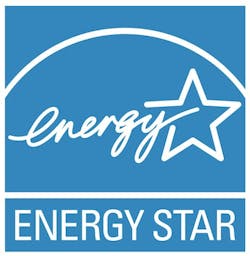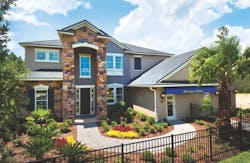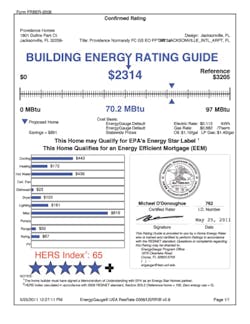Earning the Star
Energy-efficient homes are 32 percent less likely to go into default on mortgage payments compared with similar houses in the same neighborhood, according to a recent study from the University of North Carolina’s Center for Community Capital. Researchers looked at 71,000 nationally represented owner-occupied single-family homes, 21,000 of them with Energy Star certifications.
After standing pat with its flagship energy program for the first 10 years, the U.S. Environmental Protection Agency revamped the thresholds for Energy Star-backed new homes twice in the last half-dozen years against a backdrop of improving building technology and evolving energy codes.
EPA began offering the Energy Star label for new homes in 1995. At the time, guidelines focused on improvements in several key areas—high-performance windows, tight construction and ducts, efficient heating and cooling equipment—along with third-party verification from certified home energy raters.
In 2006, EPA developed more stringent guidelines across the board in response to increased mandatory national and local energy codes. Energy Star Version 2 added a thermal bypass inspection checklist, which called for visual analysis of framing areas—where air barriers are commonly missed—and insulation to ensure continuous and complete alignment. The updated standards, which became effective Jan. 1, 2007 for most residences, also required right-sized HVAC systems and strongly promoted the incorporation of efficient lighting and appliances in certified homes.
As more municipalities adopted the most recent International Residential Code (IRC) and the corresponding International Energy Conservation Code (IECC), complying with Version 2 became relatively effortless because home builders were already operating at or exceeding those guidelines. EPA says it considered 2009 IECC when establishing Energy Star Version 3 requirements the same year, and also looked at state and local codes when developing regional specifications. Furthermore, the agency weighed feedback from stakeholders and communities in two public comment periods during Version 3 advancement.
As a result, EPA unveiled its strictest national program to date, setting benchmarks for the size of new homes and stipulating each house achieve an energy-efficiency rating at least 15 percent greater than one built to the 2009 IECC standard, as well as independent confirmation that the home satisfies tougher Energy Star specifications.
The onslaught of additional inspection checklists, mandated training requirements for builders, raters, and contractors, and further reduction of energy consumption and greenhouse gas emissions outlined in Version 3 compelled EPA to introduce Version 2.5 in 2011 to help ease the transition.
Version 3 was fully implemented on Jan. 1, 2012, and the agency reports more than 3,200 builders nationwide constructed more than 100,000 Energy Star-certified houses in the following 12 months. With the exception of some low-income residences, all new homes participating in the program must meet the latest requirements to be verified and can no longer earn the Energy Star label under previous iterations.
Raising the bar
KB Home issues an Energy Performance Guide for each of its new homes to ensure maximum comfort. Photo courtesy of KB Home/APGS.
Builders must not only complete online orientation training to be eligible to build Version 3 homes, but also agree to build at least one Energy Star-certified house every 12 months to maintain their partnership. Builders must then hire a home energy rater who has completed the Energy Star Version 3 rater training with an accredited training provider and utilize an HVAC contractor who has been credentialed by an EPA-recognized industry organization. EPA also periodically offers free webinars about various technical aspects of Version 3, such as understanding HVAC checklists, and developed field guides to aid builders, raters, and contractors with implementing Version 3 code.
KB Home, one of the largest U.S. home builders, and an Energy Star partner since 2000, began working with EPA almost a year before Version 3 took effect to identify and understand the differences between the latest guidelines and their predecessors, says Dan Bridleman, the builder’s senior vice president of sustainability, technology, and strategic sourcing.
“You had to be prepared ahead of time to bring your teams together and look at ways to offset some of the costs that were coming at us,” Bridleman says, adding that KB Home tries to absorb the expense of building all of its homes to Energy Star standards by leveraging its size and scale. “We’ve been able to compete with the increasing requirements of Energy Star and not have to put huge costs in place to stay compliant.”
Builders must not only complete online orientation training to be eligible to build Version 3 homes, but also agree to build at least one Energy Star-certified house every 12 months to maintain their partnership. Builders must then hire a home energy rater who has completed the Energy Star Version 3 rater training with an accredited training provider and utilize an HVAC contractor who has been credentialed by an EPA-recognized industry organization. EPA also periodically offers free webinars about various technical aspects of Version 3, such as understanding HVAC checklists, and developed field guides to aid builders, raters, and contractors with implementing Version 3 code.
Whereas Version 2 called for five or more Energy Star-qualified appliances in a new home, Version 3 specifies all refrigerators, dishwashers, ceiling fans, and exhaust fans to be Energy Star approved, in addition to Energy Star-certified light bulbs and fixtures in 80 percent of RESNET-defined qualifying light fixture locations.
Version 3 also extends national program qualifications to ensure tighter building envelopes and demand more efficient HVAC equipment. Insulation levels must meet or exceed 2009 IECC specifications and achieve Grade I installation per RESNET; the home-energy rater’s Home Energy Rating System (HERS) Index remains the primary measurement tool for Energy Star certification. In fact, a RESNET-certified rater must use RESNET-approved testing protocol to determine a home’s envelope leakage. The target level for leakage was bumped down a notch (1 ACH50) in each U.S. climate zone in EPA’s most recent requirements.
In addition to a thermal enclosure system rater checklist, Version 3 includes HVAC system quality installation checklists for raters and contractors, as well as water management system checklists, which look at best building practices and materials to protect roofs, walls, and foundations from water damage. The increased workload for HVAC raters and contractors, in particular, adds more cost for builders because they must submit architectural plans to home energy raters for review and analysis. After a rater assists with the construction process and completes a final satisfactory inspection, an Energy Star label is issued and placed on the home’s circuit breaker box.
A new program rule postulates that if more than 10 linear feet of ductwork are located in an unconditioned attic, then a radiant, Energy Star-qualified barrier must be installed. The added guideline affects only hot climates, or IECC climate zones 1,2, and 3, where air typically leaks into the attic and not a basement. Eventually Energy Star will require all ductwork to run through conditioned space, says Mike Funk, quality coach for David Weekley Homes, the nation’s third largest privately-held home builder.
Future versions also will likely address heating water more efficiently and lowering water utility bills in general, predicts Funk, who estimates Houston-based David Weekley spends an additional $2,000 to $3,500 per house to comply with Version 3. “I think those are realistic numbers for anybody,” he says. “We thought there were going to be more issues than what there were.”
Limiting larger homes
David Weekley Homes first enrolled in Energy Star in 1999 to build certified homes such as this residence. Photo courtesy of David Weekley Homes.
One issue David Weekley Homes and other builders find in Version 3 is the introduction of target home sizes, which become instrumental in determining the HERS ratings needed for Energy Star certification. A house’s conditioned floor area, per RESNET’s standards, should be used when rating and can be found by multiplying the number of bedrooms by 600 square feet and then adding 400 square feet. Thus, one-bedroom dwellings should be 1,000 square feet, two-bedroom residences should be 1,600 square feet, three-bedroom homes should be 2,200 square feet, and so on, according to EPA.
RESNET defines a bedroom as a space of 70 square feet or greater size, with egress window and closet, used or intended for sleeping. A den, library, home office, or other similar room of at least 70 square feet with egress windows can count as a bedroom, but living rooms and foyers are ineligible. An egress window, as 2009 IECC defined, refers to any operable window that provides for a means of escape and access for rescue in the event of an emergency.
If a residence doesn’t conform to these conditioned floor area benchmarks, lower HERS ratings are needed to earn the Energy Star label. In the event a house fails to reach the target, an energy tax is levied against the residence, says Funk, who sees many homeowners in wide-open locales such as Texas struggle to satisfy target ratings because their home’s size and configuration are inconsistent with EPA prescriptions.
“Energy Star decided that they were going to tell you what size of home you should live in,” he says. “[But] even with those penalties, our homes were so energy efficient [that] they didn’t come into play.”
Ultimately, the goal of the Energy Star program is to cut a new home’s energy consumption and carbon footprint to the point where additional requirements and their associated costs do not take away from the savings built up in the bottom line.
Marketing made easy
Providence Homes builds all of its houses to Energy Star standards and guarantees each will operate at optimal energy usage. Photo courtesy of Providence Homes.
Slashing utility bills remains the most tangible, and marketable, benefit for participating in the program since its inception nearly 20 years ago.
“Since EPA began labeling new homes in 1995, Americans have saved more than $2 billion on their energy bills and reduced greenhouse gas emissions by more than 33 billion pounds,” says the agency. “In 2011 alone, families living in Energy Star-certified homes saved $493 million on their energy bills, while avoiding greenhouse gas emissions equivalent to those from more than 526,000 vehicles.”
When Providence Homes began searching in 2008 for a new strategy to separate the Jacksonville, Fla.-based builder from both the new-home and resale markets, President and COO Sean Junker decided enrolling in Energy Star would afford an immediate advantage.
“We felt that Energy Star was a little more geared toward specifically lowering utility bills, and that’s how we wanted to promote it,” he says. “We wanted the value to be that people were going to pay less per month and lower their out-of-pocket expenses.”
Providence Homes started the program with just one product line in January 2008. Three years ago, the company started building 100 percent of its new homes to Energy Star specifications and issuing a $5,000 guarantee that each house will conform to the highest construction standards and operate at optimal energy usage. The response has been overwhelmingly positive, especially from first-time buyers, says Junker. “I think the dollar value is more important to them—to have a lower cost of energy.”
Each new Providence house is subject to a comprehensive building inspection, which must be endorsed by a certified home energy rater. Image courtesy of Providence Homes.
Similarly, KB Home markets utility bill savings by issuing an Energy Performance Guide (EPG) for every new Energy Star-certified home it builds. Fashioned after miles per gallon (MPG) stickers on automobiles, EPGs detail the cost of heating and cooling a particular home each month. In Southern California, where two-kilowatt solar panel roof systems are common, KB Home saw EPGs as low as $40 per month, said Bridleman. One couple that responded to the company’s promotion seeking buyer feedback managed to double their home’s square footage and cut their energy expenses in half, he adds.
Utility bill savings for homeowners requires greater investment from builders, but the additional cost should not deter companies from committing to energy programs such as Energy Star, says Bridleman. “If you choose to be different—choose to think differently—cost shouldn’t be the limiting factor of giving the best product you can to the home buyer,” he says. “You’ve got to think of innovative ways to integrate advancements in Energy Star and advancements in codes, and do this without passing on costs to the consumer.”
Although many homeowners are hard pressed to explain the materials and processes that make their house more energy efficient, Energy Star’s national recognition and sterling reputation give them confidence when buying, says Annette Bubak, a Realtor and president of Nevada Energy Star Partners.
“They don’t know what makes it a better-performing product, they just know that product has the backing of the Energy Star brand,” she says, adding that demand for Energy Star homes has reached 91 percent nationally.
Growing consumer demand led MLS databases to include “Energy Star” as a searchable term when filtering results for home buyers, said Bubak, who thinks builders and real estate agents should continue to take a proactive approach in educating consumers and showing them exactly how they are conserving energy and saving money when they invest in an Energy Star home.
“The ones that [buyers] are going to remember are those that did a really good job positioning their product as an Energy Star high-performance home,” she says.
Many builders are still deciding whether to continue their partnership with Energy Star and comply with Version 3 requirements. To date, more than 1.4 million U.S. homes have earned the Energy Star label, according to EPA. The qualification is based on a residence’s energy performance as verified at the time of construction. Thus, the Energy Star certification never expires and does not command any follow-up action. PB




